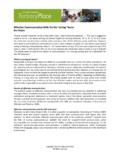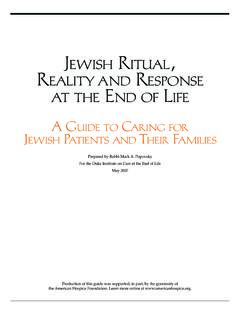Transcription of CARING FOR AUSTRALIAN FRESHWATER TURTLES IN …
1 1 CARING FOR AUSTRALIAN FRESHWATER TURTLES IN CAPTIVITY INTRODUCTION TURTLES are one of the most appealing animals of the reptile world . There are no effort free animals to keep as pets, and TURTLES are no exception. Along with the pleasure of owning a turtle comes the responsibility to provide the best possible care for it that you can. Their survival is in your hands! If basic guidelines are followed, then your turtle should thrive in captivity and may even breed whilst in your care. TURTLES are renowned for their longevity and provided your pet remains healthy, may live for thirty to seventy-five years. This point should be taken into consideration before purchasing your turtle to begin with. You are choosing a friend for life! Most AUSTRALIAN FRESHWATER TURTLES are very timid and shy, but within time will lose their fear and become accustomed to you and will recognise where their food comes from.
2 There are many stories of keepers being amused while watching a TURTLES antics in their aquatic enclosures, and many keepers go as far to say that they each have their own recognisable personalities. There is NO such thing as a Penny turtle . This was merely a generalised term given to at least four species of baby TURTLES , including the Mary River turtle , the Saw-shelled turtle and the Southern snapping turtle that were sold in pet shops in the 60 s and 70 s. The poor husbandry advice given most often led to the turtle being improperly housed without heating, filtration, adequate UVB lighting and fed an improper, low calcium diet causing the turtle to become stunted and dying in its fishbowl. There are no penny sized TURTLES in Australia that stay that small as adults. I believe that if more people keep AUSTRALIAN FRESHWATER TURTLES as pets, the more knowledge we will gain from the experience and we will be better equipped to help them in the future.
3 This will assist with the conservation & preservation of FRESHWATER turtle species by creating a safety net or assurance colony of animals being bred in captivity. As pollution increases and wetlands are filled in for development, or rivers are dammed all in the name of progress, then we must make a concerted effort to monitor the effects that these impacts are having on our wild turtle populations. Australia s most endangered reptile is the Western Swamp turtle , with wild population numbers falling below thirty in the 1980 s. This species is currently engaged in a careful breeding program under the watchful eye of turtle expert Gerald Kuchling and the Perth Zoo. Imagine how helpful it would have been if amateur herpetologists were already successfully breeding Western swamp TURTLES in captivity and could contribute to the depleted gene pool of the species.
4 Australia has some thirty+ described species and sub-species of FRESHWATER TURTLES and four monotypic genera. They naturally occur in all states and territories excluding Tasmania. There are possibly many more FRESHWATER turtle species that remain undiscovered due to their elusive and secretive nature. The correct taxonomic nomenclature that applies to AUSTRALIAN FRESHWATER TURTLES is: Kingdom - Animalia Phylum - Chordata Class: Reptilia Order - Testudines Suborder Pleurodira - (Advanced side-necked TURTLES & Primitive side-necked TURTLES ); EXCLUDING the Pig-nosed turtle (Carettochelys insculpta) which belongs to the Suborder- Cryptodira - (hidden-neck TURTLES ) which evolved approximately 260 million years ago. Members of the Suborder Pleurodira, did not evolve until the Cretaceous Period - some 135 million years ago. Reptiles in this Suborder are closely linked together by the fact that their bodies are encased in a hard shell, they curl their necks back into the shell by horizontal movement and their pelvic girdle (Ref.)
5 Fig 1) is joined to the shell. TURTLES are sometimes described as living fossils and in many respects this term is correct. Members of the Suborder Pleurodira (Advanced side-necked TURTLES ONLY) occur in Australia, South America and New Guinea. Primitive side-necked TURTLES however also occur in South America as well as parts of Africa. The difference between Advanced and Primitive side-necked TURTLES has to do with the bone structure and the arrangement of the scutes on the shell. 2 turtle , TORTOISE OR TERRAPIN The main difference is based on physiology. Tortoises are terrestrial (land dwelling) and possess thick legs and toes and require water for drinking only. There are no Tortoises native to Australia. A FRESHWATER turtle is aquatic and is not capable of swallowing food or mating unless submerged in water. They possess webbed feet or paddle-shaped, flipper-like limbs (as in the case of the Pig-nosed / Pitted-shelled turtle ).
6 Pig-nosed TURTLES will only leave the water to lay eggs. AUSTRALIAN web-footed TURTLES travel over land to nest, bask in the sun or seek more favourable conditions in circumstances including food shortage or drought. FRESHWATER TURTLES kept on dry land will dehydrate, starve and die slowly and painfully. Terrapin is merely a synonym for turtle and was derived from the North American Indian word Terrapene . Tortoise limb FRESHWATER turtle Pig-nosed turtle flipper -webbed feet like limbs TEMPERATURE CONTROL (THERMO-REGULATION) TURTLES are sometimes incorrectly regarded as cold-blooded and cannot produce their own body heat, but instead regulate their body temperature by behavioural means- (Ectothermic). Surprisingly, their body temperature can be higher than that of their environment. On warm or hot days, TURTLES may leave the water and bask, usually stretching their hind legs out behind them to attain maximum surface area or maximum contact with a warm surface, and will retreat into the water to cool down.
7 TURTLES have also been observed floating near the surface in warm water currents with outstretched limbs. Here they are able to capture valuable UV and warmth, but with the added security of being submerged. One interesting personal observation has been a turtle s reluctance to sometimes dive back into the water after it has obviously reached its preferred temperature, and occasionally submerges its head and neck in an attempt to drink and cool down. Other TURTLES sometimes appear to be crying and are releasing fluids via the eyes as part of a cooling mechanism. Basking also aids in the control of skin infections, assists in shedding scutes and helps inhibit the growth of algae on the shell. FRESHWATER TURTLES are able to gain heat much quicker than they lose it. They can also control the blood flow in their circulatory system to retain heat for as long as possible whilst submerged.
8 The colour of the carapace of a turtle also plays a role in thermo-regulation. A darker carapace will heat up more quickly than a tan or other light coloured turtle , and will be able to reach a higher temperature. Heat gained through basking and ambient temperature allows a TURTLES metabolism to increase. Female Mary River turtle basking 3 BRUMATION AND AESTIVATION In the winter months, TURTLES kept in outdoor enclosures will reduce their activity, lose interest in eating and enter a state of dormancy termed brumation. The amount of time spent brumating is governed by environmental factors and some TURTLES can be seen on warm winter days swimming around or sunning themselves. In the colder regions of Australia such as Victoria, TURTLES will brumate for longer periods than more northern species. TURTLES living in warmer climates such as the Northern Territory will not brumate and will remain active right throughout the year.
9 turtle s brumate either on land or in water, burying themselves in dirt and foliage, or mud and sediment respectively. Those that remain beneath the water are able to absorb oxygen by means of gaseous exchange. Gaseous exchange can be performed through three different processes: 1)Pharyngeal respiration - where an extremely vascularised area at the back of the mouth will take oxygen out of the )Cloacal respiration- is achieved through thin walled sacs in the cloaca, also absorbing oxygen from the )Oxygen absorption through the River turtle demonstrating Cloacal Respiration through two highly vascularised Bursa located inside the Cloaca It is important to note that most species cannot survive under the water for more than 2-3 hours without air when not in a state of dormancy. Aestivation is when a turtle buries itself in the mud at the bottom of its waterhole, or drinks as much water as it can, then leaves the water and buries itself elsewhere to escape drought conditions, or dangerously low levels of water.
10 During this time a turtle also enters a state of dormancy and slows its body processes down. Here it will remain until the water levels are restored or will perish in the event of an extended drought. DIGESTION IN TURTLES All modern TURTLES lack teeth. Short-necked TURTLES use the tough edges of their beak-like mouths to tear and dismember food. Their clawed feet are also used here to shred large food items whilst they are firmly clamped by the jaws. Long necked TURTLES are essentially ambush feeders . They strike with their mouths open, drawing in large quantities of water containing their prey. They will however eat dead fish, prawns, yabbies and insects. Food intake of all TURTLES is subject to availability, and the size and the age of each individual. TURTLES are opportunistic feeders and may instinctively gorge themselves on food in preparation for food shortages.






